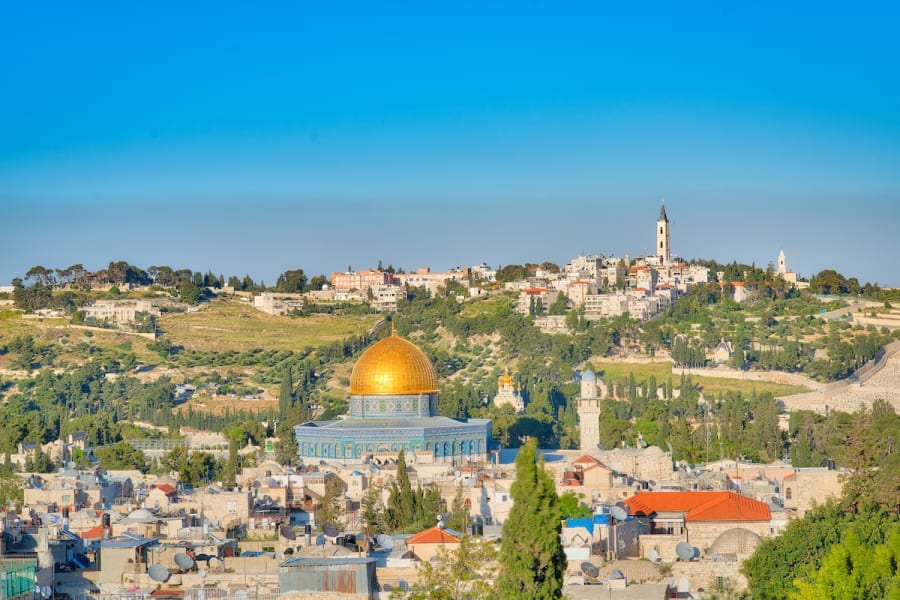The mountain where Jesus will soon return, like the rising sun

Numerous writings, including articles, books, sermons, and teachings, delve into the Mount of Olives, Jesus, his impending return, and the biblical geography of this sacred site. In the face of today's chaotic world events, Christians' attention is directed towards this divine mountain, and many believers' voices are echoing with the fervent cry: "Maranatha" – "Come, Lord, come."
The Mount of Olives is one of the main chains of hills surrounding Jerusalem. As Psalm 125:2 says, "As the mountains surround Jerusalem, so the Lord surrounds His people, from this time forth and forevermore." Thus, this mountain encircles Jerusalem from the east. It actually "represents" God himself, for it is from this mountain that Jerusalem's redemption will come.
Most Christians are familiar with the significant events on the Mount of Olives during Jesus' ministry and its prophetic role at the end of time. Noteworthy events include the raising of Lazarus in Bethany (now Al-Azaria) and Jesus' triumphant entry from Bethpage to Jerusalem, with both villages still present atop the Mount.
The Mount served as a key location for Jesus in Jerusalem. He frequently visited the Mount intentionally, often staying overnight after teaching in the temple (Luke 21:37-38). Gethsemane, where He decided to obey the Father and to give Himself, is situated at its foot. This extraordinary mountain is where Jesus ascended to heaven and is prophesied to return.
In Jewish tradition, the Mount of Olives has served as Jerusalem's primary necropolis for over 3,000 years. Dignitaries, kings, and prophets were buried at the eastern side of the city, now the Silwan neighborhood, and the western slope of the ridge/Mount. Notable tombs include the "so-called" tombs of Zechariah and Absalom, but also others such as the so-called "Pharaohs' Daughter tomb" or the "Tomb of the Royal Steward". We know also that King Uzziah was most probably buried on the Mont as well.
Gabriel Barkay, an eminent Israeli Archaeologist suggested the so-called "Absalom tomb" should be identified with a high Roman period Jewish dignitary or king such as Herod Agrippa the first (who ruled between 41-44 A.D.). The tradition of burying the dead east of the city, possibly to direct western winds away, or more likely, to designate a significant location for the day of resurrection, persists till today. Jews believe that redemption and resurrection will emanate from the East, specifically the Mount of Olives.
Muslims share a belief in the significance of the Mount of Olives, as they believe their version of Jesus, Issa, ascended to heaven from there and will return for judgment. It prompts the question: Should we follow the living Jesus, who will resurrect and judge the world, or the deceased prophet Muhammad, who won't judge?
According to Muslim tradition, a very narrow seven arches bridge connecting the Mount of Olives to the closed Golden Gate will be encountered on the Day of Judgment, allowing only the righteous to cross, while others fall into the valley of judgment, Josaphat, meaning "God has judged" in Hebrew.
Jews believe that the Shekinah, God's divine presence from the temple's holy of holies, moved to the Mount of Olives after 70 A.D. and the destruction of the Jerusalem temple. Some sources suggest that Jewish liturgy temporarily shifted to the Mount of Olives after the temple's last destruction, accessible in the absence of the temple. While the temple stood, the famous red heifer, crucial for the Day of Atonement (Yom Kippur) ritual, was slaughtered on the Mount, further emphasizing its historical significance. The Hebrew Bible tells us also that at the end of times, the Mount of Olives will be split in two from east to west, forming a great valley (Zechariah 14:3).
What more do we know about the Mount of Olives? Its name reflects its abundant olive trees, a feature that endured from ancient times until recently. The region during antiquity was a significant exporter of olive oil, especially to Egypt. Olive oil served various purposes, from everyday use to embalming. While olive trees are common throughout Jerusalem, Judea and Samaria, the Mount of Olives stands out, suggesting a deeper reason for its distinctive name.
The Mount of Olives was given this name because of its special spiritual significance in biblical geography and the sanctification of the site for a divine plan.
The olive tree symbolizes Israel ("The cultivated Olive Tree" of Romans 11:24) and the grafted Church, embodying the Messiah, as foretold in Isaiah 11:1 and Romans 15:12, which says from Jesse's roots, a branch will bear fruit (Branch is Netser נצר in Hebrew, giving us "Natsrat" נצרת, which is Nazareth – the Lord's childhood town).
It is a representation of peace, echoing Jesus as the Prince of Peace, and signifies life through the historical importance of olive oil. The tree also embodies immortality and resurrection, as demonstrated by its ability to regenerate. The longest-living untrimmed olive trees are said to be over 3,000 years old. Olive oil, used for healing (remember the good Samaritan pouring olive oil), is a spiritual symbol of invigoration and enlightenment. It holds significance in the past in temple rituals, serving as the anointing oil for lighting and consecration, including the anointing of people and kings. Finally, Christ is the light of the world, the anointed King of Kings.
East of the Temple Mount, lies this mountain as holy as its counterpart. Notably, St. Helena, mother of Constantine, erected one of the first colossal Holy Land churches on the Mount of Olives around 325 A.D. Christian tradition holds that Jesus, at this site, taught his disciples the Lord's Prayer for the second time, uttering the memorable words: "Our Father, who art in heaven [...]."
However, is there more to be gleaned from these elements? Could there be more concealed symbolism and a divine message regarding the Mount of Olives and the events that transpired there?
The Mount of Olives, situated east of Jerusalem, symbolizes resurrection as the rising sun illuminates the city with its first rays. It signifies the future glorious return of Christ, analogous to the sun reappearing in its place each morning. According to tradition, the initial sunbeams at dawn touched the Mount of Olives and entered the holy of holies of the temple. All temples in the Middle East in ancient times, as Byzantine churches would later be, had their doors facing east. Christ, as the light of the world and the Morning Star, will continue to illuminate his people and his dedicated place: The temple. In the heavenly Jerusalem, divine light from the throne will replace the need for sun, moon or stars.
The Mount of Olives is the site of divine anointing; at its feet lies Gethsemane, the place where Jesus was delivered, where He agreed to give Himself for our salvation. Located in the valley of Jehoshaphat, meaning "God has judged," Gethsemane is positioned between the Mount of Olives, symbolizing redemption and resurrection, and the temple, representing God's house.
Between is the Golden Gate, where Jesus should enter on the last day, according to tradition. The garden's name, "place of the oil press," or "Gath-Shemanim" (גת שמנים in Hebrew), was possibly called this by mistake and signified both wine and oil presses ("Gath" גת was used to call wine press, "Shemanim" שמנים means the "oils").
This convergence is poignant, reflecting the pressure and anguish Jesus experienced in the garden, where drops of blood (like wine) came out of the pores of his skin. This mirrors the pressed oil and symbolizes the anointing of the source of life. In this metaphorical wine-olive press, the olive's fruit (Jesus), the life, was crushed and bruised for us.
The resurrected Lazarus at Bethany on the Mount of Olives foreshadowed Christ's own future resurrection. God consistently imparts messages of hope to his children, steering them away from the dark path he traversed for our redemption. Lazarus experienced resurrection on the mount of life and resurrection. In contrast, Christ triumphed over death by Himself on another hill to the west, Golgotha: The west symbolizes sunset and death. Christ's victory over death was resolute and absolute.
The Mount of Olives, a profoundly rich place, holds too much for a short account, but it unequivocally imparts hope and life. Beyond its historical events, this mountain assures us that the ultimate redemption and judgment of the world will soon unfold there. Let's anticipate the imminent reappearance of sunlight, for the night will soon recede.

Aaron Goel-Angot is a Belgian-Israeli archaeologist with an expertise in antiquities identification. He is an enthusiastic numismatist and a licensed tour guide. He holds a BA degree in archaeology from the Institute of Archaeology at the Hebrew University of Jerusalem. He joined the ALL ISRAEL NEWS team as an Archaeology and Tourism correspondent. Aaron is married, father of three young children and lives in Jerusalem.
You might also like to read this:














